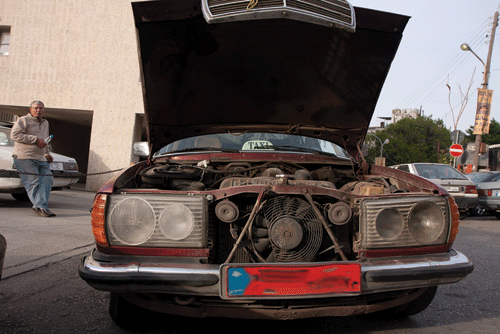Car accidents in Lebanon increase, on average, 12 to 15 percent every year according to KunHadi, an organization dedicated to road safety education. The group says that on New Year’s Eve 2010 alone, there were 24 car crashes in Lebanon resulting in 28injuries and two fatalities. The numbers scream for a robust and active insurance sector but instead Lebanon’s automotive insurance system is far behind global standards.
Its insurance industry is still the leader in the region, even after Swiss Re’s “World Insurance Report2009” said that insurance penetration as a percentage of gross domestic product had dropped from 3.4 percent in 2008 to 3.1 percent in 2009. Estimates suggest that the industry has probably reached $1 billion in premiums.
But Fateh Beckdache, general manager of BLOM Bank’s Arope Insurance, warns that any premiums growth in 2010is due to inflation and not growth. Without a financial crisis on which to blame the slowdown, less than stellar estimates for this year’s insurance financials suggest that there is something wrong under the hood. In fact, there are many idiosyncrasies within the Lebanese insurance industry that have caused a chain reaction of corner cutting and frustration on top of tumbling profitability.
The contract
Six month to one-year policies are the bread and butter of most Western auto-insurers, wherein the onus of continuation is mostly on the driver. Centralization of accidentin formation means that your crashes follow you wherever you go, making it less likely that a driver will find a more favorable rate by switching companies after a claim. In Lebanon, however, the lack of a centralized database for driving records of the insured reverses this dynamic, causing a shift in power within the driver-insurer relationship. Policies reaching up to five years are not uncommon and premiums do not rise when claims come in.
“This is very bad for the market. I don’t know why we can’t have a Centrale de Risk,” says Joseph Nasnas, chairman and chief executive officer of AXA Middle East. Insurers know that when a client submits a claim, if their premiums go up, they can easily move to another company and obtain the former rate, if not a discounted one as a reward for switching companies. Because of this, there is no disincentive to makes mall claims.
The accident
Massive claims for every little dent and scratch have caused the industry to search for disincentives. And since an overhaul of premium structure is impossible without a centralized information system, last year the industry attempted to improve the situation using a simpler tool: a deductible.
The members of the Association of Insurance Companies in Lebanon (ACAL) resolved to instate a $100deductible on claims as a group, in order to dissuade small claims and keep the playing field level among the companies. Association decisions, however, have no enforcement mechanism, leaving it up to respective companies to decide whether or not to follow its recommendations. Beckdache, who has put the deductible into effect, says that it has been very effective, estimating that it has improved Arope’s profitability by 20 percent.
“Some people used to come every month to repair their car. Now they don’t do it any more,” he says.“These are small things that make a lot of differences.”
Other companies have chosen to apply the change on a graduating scale. At AXA, Nasnas has no deductible for the first accident, but a deductible is in effect for the second, which then grows with each successive accident.
Abraham Matossian, ACAL president and chairman and CEO of Al Mashrek Insurance and Reinsurance, however, says that he has not put the deductible into action at his company, claiming that it is not necessary as his business is going smoothly.
The numbers
This all adds up to an industry struggling to improve its profitability. The deductible, though a positive step, cannot completely heal what is ailing the sector as a whole given other glaring deficiencies, like the reserve requirement structure developed by the Insurance Control Commission (ICC), the regulator for the industry.
With GDP on a steady upward course in 2010, there are systemic, and not environmental, factors that have squeezed Lebanon’s auto insurers into a profitability jam and caused them to seek outside help to persuade the ICC to change a recent ruling that they say is stifling their operations.
In 2009, the ICC raised the reserve requirement for Lebanese companies. The ICC uses a premium deficiency reserve model to determine how much cash a company must have at any given time. It uses a company’s history to determine how many claims can be expected in the following year relative to the number of policies it has on January 1, not taking into account the fact that many policies straddle the end of the fiscal year or as is often the case in Lebanon, far exceed it. For example, if a policy begins in September it will be in effect well beyond the end of the economic year.
But Jeffrey Courchene, a principal at Milliman actuary who was commissioned by the association to evaluate Lebanon’s reserve system, told Executive that this is not always the most sensitive model. “The observed profitability in recent accident years is only a proxy for the expected probability in the unearned premium. Recent improvements in price level or portfolio management will be at best only partially reflected in the results of recent accident years, although they can have a significant impact on the assessment of profitability,” he says. “The new regulatory PDR (premium deficiency reserve) formula does not allow companies to fully reflect improvements they may have made in order to improve their premium adequacy. Contracts with longer effective periods, such as five year motor policies written by banks are especially impacted by this.”
Courchene recommends a more reactive and individualized alternative; a “principles-based” approach, which takes a more nuanced, holistic approach toward quantifying risk and is growing in popularity. “There is a worldwide trend towards principles-based regulation and accounting.” But this strategy requires more elbow grease from the regulator, something seemingly in short supply at the ICC, which still hasn’t published any figures from 2008; with this in mind, implementation of a new strategy looks unlikely.
Rumblings
In the face of waning profitability, some industry players suggest that there is some precarious accounting going on as well, giving the sector a more successful outlook than it deserves. Some suggest, for example, that long-term policies, which have been “written” but not “earned,” are recorded as revenue all at once on balance sheets. This kind of fraud would certainly create a cash flow problem in the very short term but Matossian claims that if you are smart you can make a lot of money this way.
Beckdache, however, says that this kind of behavior would be impossible to sustain and thus doubts that it is in practice. “If this happens, the first year I would make a lot of money. The second year I would start bleeding. In three or four years I would go bankrupt,” he explains.
Nasnas says that without proper industry statistics there is no way to know one way or the other. “We don’t have any official figures letting us analyze the market trends. So I wouldn’t be able to know.”
But Matossian confirmed to Executive that it does occur in the local market. Further bad practices, which are not uncommon, involve “dumping,” cheap policies at the Lebanese border — insurance is mandatory for vehicles coming into the country —or at the Mechanique car inspections to customers who suddenly find themselves in need of the required quick-fix coverage, which the ‘companies’ are unlikely to honor. These practices are what caused the Ministry of Economy and Trade to shut down the American Underwriters Group in 2010.
So what?
Why should Lebanese drivers care if Lebanon’s insurance industry is a disorganized impersonation of a mature insurance market? The current system keeps premiums low and compulsory coverage even lower, making the reasons difficult to see from the perspective of one’s bank statement. But the reasons are out there on the road.
Mandatory insurance beyond third-party bodily harm and an insurance system that incentivizes good driving are the private sector’s means to improve the safety of Lebanon’s roads, a task made more urgent by last year’s accident statistics.





![Natacha-Tannous-IMG_1944[1]](https://www.executive-magazine.com/wp-content/uploads/2014/01/Natacha-Tannous-IMG_19441.gif)





